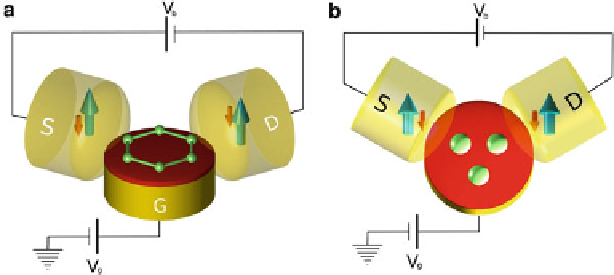Biomedical Engineering Reference
In-Depth Information
Fig. 7.13
Two examples of interference single electron transistors (I-SETs): a benzene molecular
junction contacted in the meta configuration (
a
) and a triple quantum dot artificial molecule (
b
).
The source and drain are parallel polarized ferromagnetic leads. From [
21
]
the trapped electron is achieved. Notice that we assume the leads to be parallel
polarized so that no spin torque is active in the device and we can exclude the
spin accumulation associated with that [
33
,
35
]. In conclusion, the spin-dependent
renormalization of the system dynamics introduced by
H
eff
allows to exploit
interference to achieve all-electrical control of a single electron spin in quantum
dots, a highly desirable property for spintronics [
23
-
25
] and spin-qubit applications
[
26
-
30
].
7.6.1
Spin Polarized Leads
The lead polarization
P
χ
with
χ
=
L
,
R
is defined by means of the density of states
D
χσ
at the Fermi energy for the different spin states:
D
χ
↑
−
D
χ
↓
P
χ
=
(7.52)
D
χ
↑
+
D
χ
↓
and is taken equal for the two leads
P
P
R
. The spin polarization influences the
dynamics of the system via the tunnelling rate matrices
=
P
L
=
Γ
χσ
ij
which are proportional
to the density of states
D
χσ
and enter both the definition of the tunnelling component
of the Liouvillian
L
tun
(see Eq. (
7.6
)) and the effective Hamiltonian
H
eff
(see
Eq. (
7.8
)).
The particular form of the effective Hamiltonian for the benzene and the triple
dot I-SET is the key to the understanding of the spin selective interference blockade.
For the sake of simplicity we give in the following the explicit form of
H
eff
only for
the benzene I-SET and for the ground state transition 6
g
7
g
that is characterized
by interference blocking. The argumentation is nevertheless very general and can
be repeated for all the systems exhibiting interference due to rotational symmetry.
→

